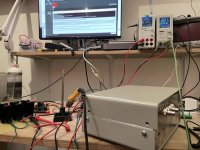@Lowe
I want to ask an age old question if I may in a world full of snake oil.
It is concerning leads on stage/studio.
My guitar output is an ethernet cable into a Line 6 Helix LT and then XLR out to the amp however my keyboard and amp out on my amp use jack to XLR.
I know that the two leads I use cost no more than £5 each, would proper Van Damme Neutrik be better?
Guiltar signal is lower level voltage signal compared to consumer line level (and professional line level is higher than that).
A cable can have a couple of characteristics that make a difference - capacitance and inductance. Without some specialist gear (LRC meter) or by sending a sweep of frequencies through the cable you'll not know if audio is being attenuated. If you have a Scarlett or sound card, then you could use the free package REW (room equalisation wizard) to sound sound out from the scarlett through the cable, and back into the scarlet. Then a bode plot will give you a frequency response that will show any drop in its ability to carry the sound. Then you have the shielding - the same sound out and in can give you an THD reading of the cable too and if it picks up any noise (you can do this by putting a left & right output and return loops next to each other and play a very loud sound through one.. placing the two cables next to see if the loud sound then is picked up on the other.
The effects of cable insulators, core spacings or even the shielding configuration are designed to ensure the signal it's designed to carry gets to the other end in the best form. In a bad design those things could end up as either a low pass filter or a high pass filters - so chopping off the highs or the lows, just like an amp tone control.
You could .. put your entire audio chain together - send a sound in and sample what comes out to the amp (or even use a calibrated microphone which is really what REW is for) to see the frequency response.
Ethernet is designed for high frequency signals in the MHz range, it will have a higher impedance than perhaps some used for audio.
Next up is single ended vs differential (ie 'balanced'). I'm assuming you're simply putting the signal into just one pin of the differential and then grounding the other pin? I have a differential ADC here I'm building:

You can see the odd connections on the box - single with the other BNC (rather than using XLR) shorted using a shorting cap.
So if you use XLR as single ended - then ground the other side.
The other alternative - is to use a single ended to differential output - either a transformer (which can have frequency attenuation but isolates you, your stage and your kit) or use an active kit that has an opamp that outputs differential output. The second should give you some boost in signal too but may not give you isolation, depends on how it's designed.
So you could test your kit - that way you have a real data/numbers based understanding of the response etc rather than opinion.






